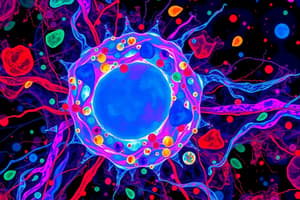Podcast
Questions and Answers
Antonie Van Leeuwenhoek used a compound microscope to observe cells.
Antonie Van Leeuwenhoek used a compound microscope to observe cells.
False (B)
Robert Hooke observed cells in a living organism.
Robert Hooke observed cells in a living organism.
False (B)
Antonie Van Leeuwenhoek was the first to call the units of life 'cells'.
Antonie Van Leeuwenhoek was the first to call the units of life 'cells'.
False (B)
Robert Hooke observed cells in the foot-web of a frog.
Robert Hooke observed cells in the foot-web of a frog.
Robert Hooke's microscope used a single lens to observe objects.
Robert Hooke's microscope used a single lens to observe objects.
What was the key difference between the microscopes used by Antonie Van Leeuwenhoek and Robert Hooke?
What was the key difference between the microscopes used by Antonie Van Leeuwenhoek and Robert Hooke?
Explain the significance of Antonie Van Leeuwenhoek's discovery, even though he didn't coin the term 'cell'.
Explain the significance of Antonie Van Leeuwenhoek's discovery, even though he didn't coin the term 'cell'.
What specific material did Robert Hooke examine to observe the first cells?
What specific material did Robert Hooke examine to observe the first cells?
Why did Robert Hooke call the structures he observed 'cells'?
Why did Robert Hooke call the structures he observed 'cells'?
What was the primary difference in the objects observed by Antonie Van Leeuwenhoek and Robert Hooke?
What was the primary difference in the objects observed by Antonie Van Leeuwenhoek and Robert Hooke?
Flashcards are hidden until you start studying
Study Notes
Antonie Van Leeuwenhoek
- Born in 1632 and died in 1723, known for developing a simple microscope with a single biconvex lens.
- First individual to observe living cells, specifically blood cells in frog foot-web capillaries.
- Recognized cells as living units of all organisms, though he did not use the term "cells."
Robert Hooke
- In 1665, introduced a two-lens microscope to examine various materials.
- Studied a thin slice of dead cork, observing box-like structures resembling small cubicles.
- Coined the term "cells" based on the resemblance to monks' living quarters in a monastery.
Antonie Van Leeuwenhoek
- Born in 1632 and died in 1723, known for developing a simple microscope with a single biconvex lens.
- First individual to observe living cells, specifically blood cells in frog foot-web capillaries.
- Recognized cells as living units of all organisms, though he did not use the term "cells."
Robert Hooke
- In 1665, introduced a two-lens microscope to examine various materials.
- Studied a thin slice of dead cork, observing box-like structures resembling small cubicles.
- Coined the term "cells" based on the resemblance to monks' living quarters in a monastery.
Studying That Suits You
Use AI to generate personalized quizzes and flashcards to suit your learning preferences.





